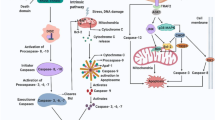Abstract
An integrated microscopic study of the destruction of mouse Ehrlich ascites carcinoma (EAC) cells under starvation conditions has been carried out. It has been found that, in addition to apoptosis, necrosis, and apoptotic necrosis, already known for EAC, cell destruction can also occur through mitochondrial autolysis, which is proposed to be considered a new kind of mitoptosis. A mitoptosis in EAC is characterized by the appearance of many autolyzing mitochondria, the fusion of which leads to rupture of the cell membrane and the ejection of the nucleus from the cell. It is assumed that the polymorphism of EAC destruction patterns is explained by the different physiological state of the cells, which determines the “choice” of the cell death mechanism. This situation poses a challenge for researchers to develop complex inducers with the ability to stimulate all possible types of cancer cell death.

Similar content being viewed by others
REFERENCES
Bruin, D.E.C. and Medema, J.P., Cancer Treat. Rev., 2008, vol. 34, pp. 737–749. https://doi.org/10.1016/j.ctrv.2008.07.001
Rufini, A. and Melino, G., Biochem. Biophys. Res. Commun., 2011, vol. 414, pp. 445–450. https://doi.org/10.1016/j.bbrc.2011.09.110
Dimou, A., Syrigos, N.K., and Saif, M.W., Ther. Adv. Med. Oncol., 2012, vol. 4, pp. 271–279. https://doi.org/10.1177/1758834012446008
Moriwaki, K. and Chan, F.K.M., Genes Dev., 2013, vol. 27, pp. 1640–1649. https://doi.org/10.1101/gad.223321.113
Cho, Y.S. and Park, S.Y., Biomol. Ther., 2014, vol. 22, pp. 167–175. https://doi.org/10.4062/biomolther.2014.046
Osorio-Vega, H., Finol, H.J., Roschman-Gonzalez, A., et al., Acta Microsc., 2016, vol. 25, pp. 65–70.
Reunov, A.A., Reunov, A.V., Pimenova, E.A., et al., Gene, 2018, vol. 658, pp. 1–9. https://doi.org/10.1016/j.gene.2018.03.012
Ozaslan, M., Karagoz, I.D., Kilic, I.H., et al., Afr. J. Biotechnol., 2011, vol. 10, pp. 2375–2378. https://doi.org/10.5897/AJBx10.017
Da Mota, M.F., Benfica, P.L., Batista, A.C., et al., J. Ethnopharmacol., 2012, vol. 139, pp. 319–329. https://doi.org/10.1016/j.jep.2011.04.055
Osman, A.M.M., Alqahtani, A.A., Damanhouri, Z.A., et al., Cancer Cell Int., 2015, vol. 15, pp. 104–117. https://doi.org/10.1186/s12935-015-0258-1
Menchinskaya, E.S., Pislyagin, E.A., Kovalchyk, S.N., et al., Chemotherapy, 2013, vol. 59, pp. 181–191. https://doi.org/10.1159/000354156
Reunov, A.A., Reunov, A.V., Pimenova, E.A., et al., RAS Rep. Biol. Sci., 2015, vol. 462, pp. 161–163. https://doi.org/10.1134/S0012496615020040
Chaabane, W., User, S.D., El-Gazzah, M., et al., Arch. Immunol. Ther. Exp., 2013, vol. 61, pp. 43–58. https://doi.org/10.1007/s00005-012-0205-y
Jangamreddy, J.R. and Los, M.J., Hepat. Mon., 2012, vol. 12, e6159. https://doi.org/10.5812/hepatmon.6159
Lyamzaev, K.G., Nepryakhina, O.K., Saprunova, V.B., et al., Biochim. Biophys. Acta, 2008, vol. 1777, pp. 817–825. https://doi.org/10.1016/j.bbabio.2008.03.027
ACKNOWLEDGMENTS
We are grateful to D.V. Fomin for the help in using the equipment of the Center for Shared Use of the NSCMB FEB, Russian Academy of Sciences (Vladivostok, Russia). Part of the study was carried out at the Electron Microscopy Laboratory of the University of St. Francis Xavier (Antigonish, Nova Scotia, Canada).
Author information
Authors and Affiliations
Corresponding author
Ethics declarations
Conflict of interests. The authors declare that they have no conflict of interest.
Statement on the welfare of animals. All applicable international, national, and/or institutional guidelines for the care and use of animals were followed.
Additional information
Translated by I. Shipounova
Rights and permissions
About this article
Cite this article
Pimenova, E.A., Reunova, Y.A., Menchinskaya, E.S. et al. An Unusual Pathway of Mitoptosis Found in Ehrlich Carcinoma Cells. Dokl Biol Sci 494, 240–243 (2020). https://doi.org/10.1134/S0012496620050063
Received:
Revised:
Accepted:
Published:
Issue Date:
DOI: https://doi.org/10.1134/S0012496620050063




